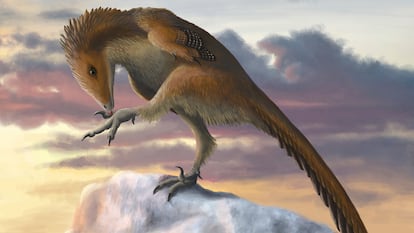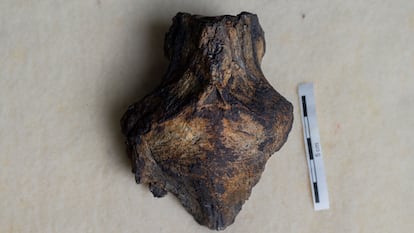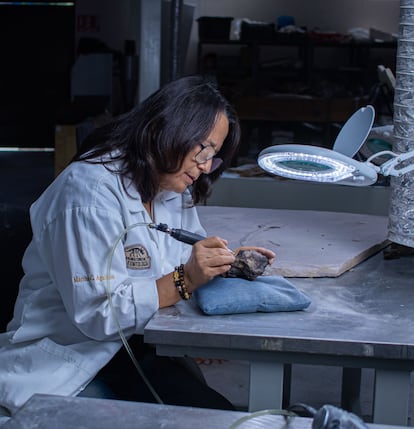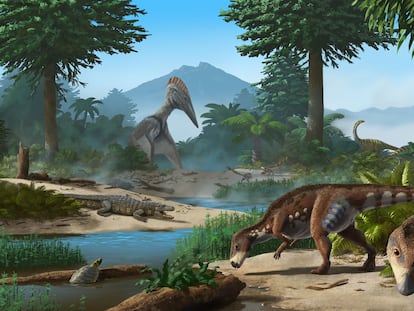This was the first carnivorous dinosaur with superior intelligence discovered in Mexico
The fossil corresponds to an agile hunter with highly developed senses; its finding adds another piece to the puzzle that seeks to reconstruct the world before the extinction of the dinosaurs


In March 2007, the Mexican paleontologist Martha Carolina Aguillón made a unique discovery. Among the rocks of Cerro del Pueblo, a geological formation in the south of the state of Coahuila, the expert found the remains of a small skull; a “mysterious piece” that did not match any of the dinosaurs that had been identified in the region. Sixteen years and dozens of analyzes later, the fossil has revealed that the troodontids, a group of carnivorous dinosaurs whose brain capacity was greater than that of any other species, inhabited Mexico more than 74 million years ago. The discovery not only increases the diversity of dinosaurs found in Coahuila – a state that has made the effort to unearth a legacy unseen until just three decades ago and whose Desert Museum serves as the most relevant dinosaur research and dissemination center in the country – but in addition, it provides a new piece to the geological puzzle that seeks to paint a picture of the world just before the extinction event that put an end to the age of the dinosaurs.
“The dinosaur we found is small to medium-sized and, as such, its bones should have been very fragile,” Aguillón explains to EL PAÍS, noting the improbability of the find. The remains of the skull, which include the frontal and parietal bones of the troodontid, fought a battle against time before they were found, avoiding all kinds of obstacles, from being destroyed by scavengers to being crushed by millions of years of land movements. “Since they are very small, if they become fossilized they are difficult to find, and if you do find them they are even harder to identify. That is what makes this finding is so significant,” says the person responsible for the discovery, the latest in a series of extinct giants that in recent decades, thanks to a campaign by the state government, have positioned Coahuila as a “land of dinosaurs.”

Approximately 74 million years ago, the panorama in southern Coahuila was very different. Instead of the dry climate and the semi-desert landscapes that prevail in the region today, dense subtropical vegetation made its way through swamps and lakes all the way to the beach of the ancient Tethys Sea. This warm and humid environment prompted the appearance of large herbivores, and with them, carnivores of all sizes in search of prey. With a body covered in feathers, the 4.3-foot-tall and just over eight-foot-long dinosaur did not reach the magnitude of the large tyrannosaurids that also inhabited northern Mexico. However, it had a unique characteristic that for decades has been a controversial object of study for paleontologists: a brain capacity greater than that of any other dinosaur.
“Since the 1970s, they began to think that this dinosaur was the most intelligent one due to the size of its skull in general, which implies a fairly large brain capacity in relation to its dimensions if we compare it, for example, with the Tyrannosaurus rex, which measured 40 feet but had a brain of about 12 inches. Intelligence is subjective, but it is the dinosaur with the largest brain in relation to its body,” explains Héctor Rivera Sylva, head of the Department of Paleontology at the Desert Museum. The remains of the skull reveal that it had highly developed vision, with large eyes positioned towards the front, as well as a keen sense of smell, traits that make the experts speculate about its possible nocturnal habits. “This dinosaur must have gone after small prey such as snakes, mammals and lizards that have been found in the same geological formation, as well as baby dinosaurs. We knew that it had a particular ecological role, because it’s the hunter that was missing,” says Aguillón.

The dinosaur, which belonged to the troodontid family and whose species is yet to be determined, will be recreated with a full-scale model by a group of paleosculptors advised by Aguillón and Rivera and exhibited at the Desert Museum, which for 23 years has housed the most important paleontological discoveries in Mexico, including the velafrons coahuilensis, a six-ton, 23-foot-long herbivore that rose to fame after becoming the first dinosaur named in Coahuila, as well as the most complete ever found in Mexico. The discovery, made in April 1995 by a team led by Martha Carolina Aguillón, was key to the state’s paleontology boom, which brought unprecedented government investment and international scientific cooperation that opened the door to the identification of dinosaurs in the country. “We could be drastic and say that we are taking our first baby steps, or we could be enthusiastic and claim to be at the forefront of this type of study. We are still in the inventory stage, finding out what we have, as Coahuila completes the book of life in the history of dinosaurs and other living beings,” concludes Aguillón.
Sign up for our weekly newsletter to get more English-language news coverage from EL PAÍS USA Edition
Tu suscripción se está usando en otro dispositivo
¿Quieres añadir otro usuario a tu suscripción?
Si continúas leyendo en este dispositivo, no se podrá leer en el otro.
FlechaTu suscripción se está usando en otro dispositivo y solo puedes acceder a EL PAÍS desde un dispositivo a la vez.
Si quieres compartir tu cuenta, cambia tu suscripción a la modalidad Premium, así podrás añadir otro usuario. Cada uno accederá con su propia cuenta de email, lo que os permitirá personalizar vuestra experiencia en EL PAÍS.
¿Tienes una suscripción de empresa? Accede aquí para contratar más cuentas.
En el caso de no saber quién está usando tu cuenta, te recomendamos cambiar tu contraseña aquí.
Si decides continuar compartiendo tu cuenta, este mensaje se mostrará en tu dispositivo y en el de la otra persona que está usando tu cuenta de forma indefinida, afectando a tu experiencia de lectura. Puedes consultar aquí los términos y condiciones de la suscripción digital.










































